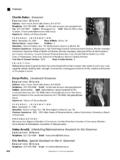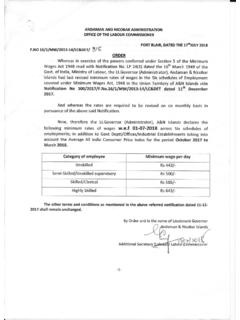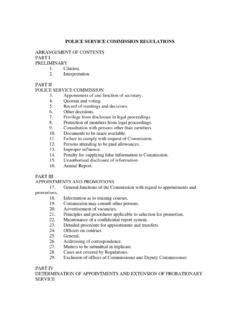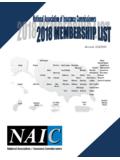Transcription of OFFICE OF THE COMMISSIONER GUIDANCE - ct.gov
1 OCG-4 OFFICE OF THE COMMISSIONER GUIDANCE Regarding the Connecticut Treatment of the Federal Repatriation Transition Tax under IRC 965 General Under the recently enacted federal tax reform, certain taxpayers with untaxed foreign earnings and profits are required to include their accumulated post-1986 deferred foreign income ( Section 965 income ) in their Subpart F income in the 2017 taxable year. For federal tax purposes, this income is subject to tax at special effective tax This is referred to as the repatriation transition tax.
2 Federal law allows certain taxpayers to elect to defer payment of a portion of their repatriation transition tax. This election, however, does not defer recognition of the Section 965 income. Therefore, the Section 965 income, in its entirety, is recognized and must be included on a taxpayer s federal return for its last taxable year beginning before January 1, 2018. On March 13, 2018, the Internal Revenue Service released IRC 965 Transition Tax Statement, which corporations and certain trusts must use to report their Section 965 income and calculate their repatriation transition tax.
3 This statement must be attached to such taxpayers 2017 federal returns. This OCG is intended to provide information about how to report Section 965 income on Connecticut tax returns. Additional federal GUIDANCE is expected, and this OCG may be updated if necessary. Connecticut Tax Treatment of Section 965 Income A taxpayer must report its Section 965 income, in its entirety, on its 2017 Connecticut return. Connecticut conforms to the federal rule that such income is recognized and must be included on a taxpayer s return for its last taxable year beginning before January 1, 2018.
4 Connecticut, however, does not allow a taxpayer to elect to defer payment of any portion of the tax associated with its Section 965 income. Connecticut treats Subpart F income as dividend income. Therefore, because Section 965 income is treated as Subpart F income for federal tax purposes, Connecticut will treat such income as dividend income. 1 Under 965, deductions are provided to achieve the special effective tax rates set forth in statute. Original Issue Date: 4/6/2018 Last Updated: 5/11/2018 Page 2 of 5 I.
5 Corporation Business Tax 1) How will Connecticut treat Section 965 income for Corporation Business Tax purposes? (Answer revised on May 11, 2018) Connecticut provides a dividend received deduction ( DRD ) that fully offsets the dividend income that a corporation received from foreign corporations to the extent such income is not otherwise deducted. Accordingly, even though a corporation must include the full amount of its Section 965 income on its 2017 Connecticut return, it is then entitled to claim a deduction equal to such After a corporation claims the DRD, Connecticut then requires the corporation to add back its expenses that are related to its dividend income.
6 Under legislation that has recently passed both chambers of the Connecticut General Assembly and is awaiting Governor Malloy s signature, expenses related to dividends would be set at 5% of the dividend income. This legislation would be effective for income years commencing on or after January 1, 2017. Thus, a corporation would multiply its Section 965 income by 5% to determine its expenses related to dividend income. 2) How must a corporation report Section 965 income on its 2017 Connecticut Corporation Business Tax Return? (Answer revised on May 11, 2018) Corporations with Section 965 income must report the full amount of such income on Line 9 of their Form CT-1120, Schedule D for income year In general, the Section 965 income that must be reported is found on Line 1 of the federal IRC 965 Transition Tax Statement.
7 Corporations also must report the full amount of their Section 965 income as dividend income on Form CT-1120 ATT, Schedule I, Column A for income year 2017. This income must be included in the amounts reported on Line 1 and Line 3 of Form CT-1120 ATT, Schedule I, Column A. Corporations must report their expenses related to the Section 965 income on Line 3 of CT-1120 ATT, Schedule I, Column D. Under the legislation currently awaiting Governor Malloy s signature, such expenses reportable in Column D would equal 5% of the Section 965 income.
8 2 For the purposes of simplicity, a corporation should claim a 100% DRD against its Section 965 income and disregard the deductions described in footnote 1. Note, however, that no DRD is allowed for income tax purposes (Form CT1040, Form CT-1040NR/PY, Form CT-1041 and Form CT-1065/CT-1120SI). 3 For combined unitary filers, this amount should be included on Line 8 of Form CT-1120CU-NI, Part II. Page 3 of 5 II. Income Taxes 1) How must a taxpayer report Section 965 income on the 2017 Form CT-1040, Connecticut Resident Income Tax Return, and Form CT-1040NR/PY, Connecticut Nonresident and Part-Year Resident Income Tax Return?
9 For federal income tax purposes, an individual taxpayer is required to report the net Section 965 amount (Section 965(a) amount reduced by the Section 965(c) deduction) on Form 1040, page 1, Line 21, Other Income. For Connecticut income tax purposes, the starting point in determining a taxpayer s Connecticut income tax liability is federal adjusted gross income, Line 37 on federal Form 1040. Because the net Section 965 amount will already be included in the taxpayer s federal adjusted gross income, a resident taxpayer is not required to report such amount separately on Form CT1040.
10 A nonresident individual, however, who receives a Schedule CT-K1 from a pass-through entity reporting Connecticut-sourced Section 965 income, or who receives other information or documentation directly from a specified foreign corporation reporting income relating to Connecticut-sourced Section 965 income, must report the associated income and deductions on the appropriate lines on Schedule CT-SI, Nonresident or Part-Year Resident Schedule of Income From Connecticut Sources, and on Form CT-1040NR/PY. 2) How must a taxpayer report Section 965 income on the 2017 Form CT-1041, Connecticut Income Tax Return for Trusts and Estates?
















